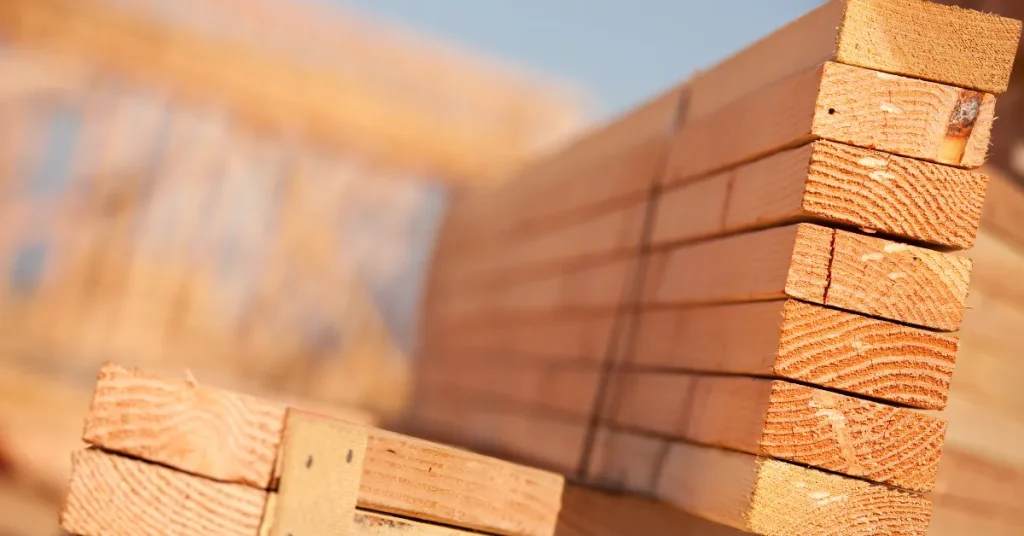A 4×4 lumber traditionally measures 3.5 inches by 3.5 inches in thickness. This nominal size differs from the actual dimensions due to the planing process after cutting.
Understanding lumber dimensions proves essential for any construction project or DIY task, and a 4×4 piece of wood is no exception. Despite its name, which might imply a full four-inch square measurement, a 4×4’s size is less due to the milling process that smooths and finishes the wood for commercial sale.
Remembering these standardized sizes helps in accurately planning projects and ensuring stability in structures. This knowledge also aids in estimating costs and material needs before making a trip to the hardware store. Grabbing a tape measure before purchasing can save valuable time and resources, ensuring your project runs smoothly from start to finish.

Behind The Numbers: Decoding Lumber Size Labels
Understanding lumber dimensions is key to any building project. Lumber size labels can be misleading. They often do not match the actual dimensions of the wood. This section will decode the true sizes behind those numbers.
Myths And Realities Of Lumber Dimensions
It’s common to hear about 4x4s and assume they measure four inches by four inches. But that’s not true. The actual size is often less than the nominal label. Let’s dive into what these numbers really represent in the lumber world.
- A 4×4’s true size is usually 3.5 inches by 3.5 inches.
- The label represents the dimensions before the lumber is dried and planed.
- Always check the actual measurements before buying lumber for a project.
Standard Naming Conventions In The Lumber Industry
Naming conventions in lumber can seem complex. But they follow a standard that many industries use. This makes finding and using the right wood simpler.
| Nominal Size | Actual Size |
| 2×4 | 1.5 x 3.5 inches |
| 2×6 | 1.5 x 5.5 inches |
| 4×4 | 3.5 x 3.5 inches |
This table shows typical lumber sizes. You can find different wood types at these sizes. It’s the same for softwood, hardwood, and engineered wood. Always refer to the actual size for precise measurements.
Measuring Up: The Actual Thickness Of A 4×4
Understanding the true size of construction lumber like 4x4s is vital for any project. It can affect stability, design, and overall success. Let’s dive into what a 4×4 really measures up to.
The Nominal Vs. Actual Dimension Mystery
In the lumber world, ‘nominal’ refers to the size by name. ‘Actual’ is the true measurement. Lumber undergoes cutting, drying, and planing which reduce its size.
Why Your 4×4 Isn’t Really 4 Inches By 4 Inches
A “4×4” is a label, not a precise guide. After processing, this common piece of wood usually measures closer to 3.5 inches by 3.5 inches. Let’s unpack why this size change happens.
- Drying: Wood shrinks as it loses moisture.
- Planing: Smoothing the surface reduces size slightly.
- Industry Standards: Sizes are based on pre-dried dimensions.
Sawn Lumber Sizes: From Forest To Frame

Sawn lumber plays a key role in construction and woodworking projects.
The journey from a towering tree to sturdy framing material involves many steps.
Understanding how a 4×4 piece of lumber gets its dimensions is essential.
The Process Of Dimensional Reduction
Lumber starts its life as a part of a forest. Once harvested, logs head to a mill.
Here, they are cut into rough sizes.
- Felled trees are trimmed of branches.
- Logs are then transported to a sawmill.
- Large saws cut logs into desired thicknesses.
A 4×4 timber, for instance, begins slightly larger than its final size.
This accommodates for later processing steps.
Effects Of Drying And Planing On Lumber Measurements
After cutting, wood needs to dry. This reduces its moisture content.
Drying can cause shrinking. Wood also warps and twists sometimes.
Planers smooth the wood. They also make the size more uniform.
A nominal 4×4 is often not exactly 4 inches by 4 inches.
| Nominal Size | Actual Size (Dried and Planed) |
| 4×4 | 3.5 inches x 3.5 inches |
This table shows typical lumber size changes.
It helps users know what size they are really buying.
Common Uses For 4×4 Lumber In Construction

Imagine building a house, a deck, or a bench. What do all these projects have in common? They often use 4×4 lumber for its strength. Here, let’s dive into how 4×4 pieces shape our homes and yards.
4×4 lumber is a powerhouse in construction. Its sturdiness makes it the go-to for many building needs. From framing to posts, 4x4s offer vital support.
Structural Applications And Load-bearing Considerations
- Beams and posts
- Foundation work
- Support for decks and pergolas
Structurally, 4×4 lumber holds up roofs and joins walls. It’s essential for creating strong, safe homes. In the yard, it supports decks and outdoor spaces.
4x4s must handle heavy loads. Think about snow on a roof or a family dancing on a deck. The wood keeps everything stable and safe.
Creative Projects That Utilize 4×4 Pieces
| Project | Use |
| Garden beds | Frames to hold soil |
| DIY furniture | Legs for tables and chairs |
| Play structures | Supports for swings and forts |
Creatively, 4×4 lumber brings projects to life. From custom garden beds to playful treehouses, the possibilities are endless.
Navigating The Purchase: Tips For Buying The Right Lumber
Choosing the correct lumber for your project is a key step. You’ll want strong, straight boards that match your needs. Understanding lumber dimensions—like a 4×4’s actual thickness—is vital. This guide provides tips for buying the right lumber for your project.
How To Read Lumber Labels Like A Pro
Reading lumber labels correctly ensures you get what you pay for. Follow these steps:
- Look for the nominal size, which is the name of the lumber. For instance, a 4×4.
- Find the actual size, which is slightly less than the nominal size. A 4×4 typically measures 3 1/2 inches thick.
- Check the grade. This tells you the wood quality. Select the one best for your project.
- Wood type matters. Each wood has different characteristics and prices.
- Look for special treatments, like pressure-treating, if needed for your project.
Questions To Ask Before Taking 4×4 Lumber Home
Before you buy, make sure the lumber meets your expectations. Here are questions to ask:
| Question | Why It’s Important |
| Is this the actual size I need? | To confirm the lumber fits your project specifications. |
| Is the lumber straight? | Straight wood ensures structural integrity and aesthetic appeal. |
| What is the moisture content? | Too much moisture can lead to warping or shrinking. |
| Is the treatment suitable for indoor/outdoor use? | Assures the lumber will last in its intended environment. |
| What’s the return policy? | Knowing the store’s policy helps if you need to make a return. |
Alternative Options And Future Trends In Lumber Sizing
Making sense of lumber dimensions can surprise many. Traditional lumber, like the common 4×4, doesn’t always match its name in thickness. The future brings exciting changes and alternative options for builders and DIY enthusiasts. Let’s explore what’s on the horizon.
The Rise Of Engineered Wood Products
Engineered wood products are transforming construction. They come in precise, reliable sizes. These products include:
- Laminated veneer lumber (LVL)
- Cross-laminated timber (CLT)
- Glulam beams
Builders love these materials for their strength and uniformity. They defy traditional sizing limits. Expect to see more buildings taking advantage of their benefits.
Sustainability And Changes In Lumber Standards
As the world focuses on sustainability, so does the lumber industry. New standards focus on eco-friendly practices. Here are a few changes:
- Greater use of smaller, faster-growing trees
- Recycling and reusing wood materials
- Adoption of composite products
This shift impacts lumber sizes and types available to consumers. As a result, the traditional 4×4 might get a green makeover or see competition from greener options.
FAQs About How Thick Is A 4×4
What Size Is A 4×4?
A 4×4 refers to a vehicle with four-wheel drive. The term does not specify size, which varies by make and model. It indicates the drivetrain’s ability to power all four wheels simultaneously, enhancing traction.
Is A 4×4 Really 4 Inches?
No, a 4×4 lumber piece typically measures 3. 5 inches by 3. 5 inches. The “4×4” label is a nominal size before the lumber undergoes drying and planing.
What Are The Actual Dimensions Of A 4×4 Post?
The actual dimensions of a nominal 4×4 post are typically 3. 5 inches by 3. 5 inches due to the finishing process.
Conclusion
Understanding the true dimensions of a 4×4 is crucial for any construction or woodworking project.
We’ve explored the nominal versus actual size variance that often confuses novice builders. Always remember to measure before cutting, as nominal sizes differ from actual dimensions.
This small step ensures your builds are precise and your structures sound.
Resources:
1. https://bof.fire.ca.gov/media/llad34j2/full-14-b-presentation-structural-lumber-grading-basics-july-2021.pdf
